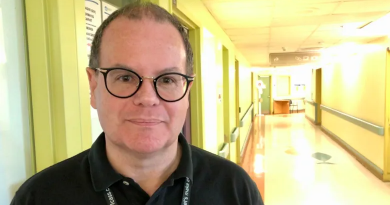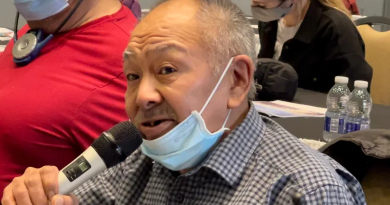Blog – The Fairbanks ministerial: What to expect

For the tenth time since 1998, the eight Arctic states and six Permanent Participants will gather together as an Arctic Council to discuss environmental protection and sustainable development in the region.
This year it is being held in Fairbanks, as the United States concludes its two-year tenure at the helm and passes the Chairmanship along to Finland. Here’s a rundown of what to expect to see on May 11.
Who’s Who
The official Chair of the Arctic Council is usually the host’s Foreign Minister; the exception was Leona Aglukkaq, an Inuk who was the Environment Minister during Canada’s 2013-15 Chairmanship. For the United States, it’s the Secretary of State. Although John Kerry received the gavel on behalf of the United States in Iqaluit in 2015, it will be Rex Tillerson handing it off to Finnish Foreign Minister Timo Soini this week.

The day to day management of the Arctic Council is led by Senior Arctic Officials (SAOs) for the eight Arctic states, and Heads of Delegation (HoDs) for the Indigenous Permanent Participants (PPs). Host countries appoint an SAO Chair while retaining a separate national representative. David Balton, who is also the U.S. Ambassador for Oceans and Fisheries, has ably led the Council for the past two years. He will be succeeded by Aleksi Härkönen, the current Finnish SAO. René Söderman will return to the Council as Finland’s SAO for the next two years.
Admiral Robert Papp, who was appointed U.S. Special Representative for the Arctic in 2014, resigned from his post sometime after the election of Donald Trump. He is now a lobbyist for a shipbuilding company. No replacement has been named.
Observers 5.0
The Observer drama will continue, with the European Union – four times a bridesmaid – looking to escape ad hoc status once and for all. Twenty applications for new Observer status – four states, six intergovernmental organizations, and ten non-governmental organizations – will be considered, based on the criteria established in Nuuk in 2011. It is likely that some, but not all, will succeed.
The Trump Effect

The US Chairmanship prioritized climate change when it assumed the Chairmanship back in 2015. But the Trump Administration obviously has a different take on the issue than the Obama Administration did.
The only appreciable effect on the Arctic Council one should expect this week from the Trump Administration is a softening of the language around addressing climate change in the Fairbanks Declaration. Watch whether the Paris Agreement is referenced, or not, in the Declaration; and how the other 15 delegations discuss climate change in their spoken remarks. There will likely be some careful, and pointed, wording.
The Finnish Transition
Finland published their full Chairmanship Program last week, promising to focus on Environmental Protection, Meteorological Cooperation, Connectivity, and Education. There is significant continuity from the American Chairmanship, which is welcome; but a Finnish fingerprint for sure.
Meteorological cooperation is no doubt important, but it’s never been highlighted before and seems a bit of an odd choice. The decision to prioritize education is likely a reflection of Finland’s international reputation for leadership in that area, and to the fact that the University of the Arctic has its Secretariat in Rovaniemi. Watch for more involvement of the EU; and a potential Arctic Summit for heads of state – including Trump and Putin – if there are “favorable international conditions”.
An Arctic Science Cooperation Agreement
The third legally binding agreement negotiated under the auspices of the Arctic Council will be signed in Fairbanks: the Agreement on Enhancing International Arctic Scientific Cooperation. It is meant to break down barriers to conducting Arctic science, including entry and exit of persons, equipment and materials; access to research infrastructure and facilities; and access to research areas. It covers terrestrial, coastal, atmospheric and marine areas. It will be interesting to see what language is adopted around the incorporation of traditional knowledge.
Two notable things about this Agreement: (1) the Arctic 8 decided to keep it to themselves rather than have non-Arctic states join as full parties, though there are provisions for scientists from Observer states to benefit from the Agreement; and (2) the United States and Russia jointly Chaired the negotiation process – a nice example of mutual respect and benefit in a messy world order.
The Working Groups Strike Back

After being largely marginalized at the Iqaluit Ministerial, the Working Groups have taken a more proactive approach to communicating their work. Perhaps most prominently, the Arctic Monitoring and Assessment Programme (AMAP), the Arctic Council’s best funded Working Group by far, released its major deliverable at an international conference in Virginia two weeks ago: the Snow, Water, Ice, and Permafrost in the Arctic (SWIPA) report. With its dire finding that “the Arctic is shifting—rapidly and in unexpected ways—into a new state”, it obtained a level of international media coverage rarely bestowed on the Arctic Council itself.
Amongst the deliverables expected from the other Working Groups:
- State of the Arctic Marine Biodiversity Report (SAMBR)
- Arctic Invasive Alien Species Strategy (ARIAS):
- Arctic Protected Areas indicator report
- Circumpolar Oil Spill Response Viability Analysis
- The Economy of the North (ECONOR III)
- Reducing the Incidence of Suicide in Indigenous Groups – Strengths United through Networks (RISING SUN)
- Water, Sanitation and Health (WASH)
- Arctic Renewable Energy Atlas (AREA)
- Arctic Remote Energy Networks Academy (ARENA)
“The Arctic Council on Steroids”
The US Chairmanship saw the establishment of an Alaska Arctic Council Host Committee to “effectively welcome visiting delegations, inform Alaskans of Arctic Council activities and link decision-makers to the realities, richness and responsibility of Alaska’s Arctic.” In true Alaskan fashion, the host committee has gone big, with literally dozens of events, outlined in a 24-page program, planned for a “Week of the Arctic” in Fairbanks and Anchorage. Lapland plans to follow suit with its own Host Committee convened for the Finnish Chairmanship.
What’s the Big Deal Anyway

The Council is often conceived as a policy-maker for all things Arctic, governing shipping, oil drilling and climate change in the region. It isn’t: the 1996 Ottawa Declaration, which established the Arctic Council, ensured it was a rather informal forum, not a supranational organization. It has matured over the past twenty years, but it doesn’t have any legal powers – it is still up to states to implement environmental laws and regulations, or not – and it is proscribed from discussing military security issues.
So what does that leave to discuss in Fairbanks? A lot of the Council’s actual work is technical and scientific; even boring. But what you’ll witness this week is one of the finest examples of international cooperation in the 21st century: Russia and the West genuinely collaborating, Indigenous nations given an equal voice as states, a privileging of scientific evidence, and proactive approaches to environmental protection.
If, like me, your quota for political drama has already been filled for the year, then curl up with an Arctic Council Working Group report and be soothed by the unapologetic wonkiness. Just don’t choose the SWIPA – that one’s terrifying.
Related stories from around the North:
Canada: Canada’s foreign affairs minister looks to thaw relations with Russia at Arctic summit, Radio Canada International
Denmark/Greenland: Q&A: Impact assessments in the Arctic – What Canada and Greenland can learn from each other, Eye on the Arctic
Finland: Finland’s foreign minister visits Washington en route to Arctic Council summit, Yle News
Iceland: The Arctic Council at 20 – View from Iceland, Eye on the Arctic
Norway: Norway and Finland talk Arctic with China, The Independent Barents Observer
Russia: Moscow says NATO meeting in the Arctic is a provocation, The Independent Barents Observer
Sweden: Swedish foreign minister to meet Russian counterpart, Radio Sweden
United States: Senior Arctic Official David Balton on what makes Arctic Council so unique (Part 1 of 2), blog by Heather Exner-Pirot
The Arctic Council chairmanship moves from the United States to Finland on May 11, 2017 in Fairbanks, Alaska. Eye on the Arctic’s Eilís Quinn along with EOTA media partners and contributors will be bringing you stories, interviews and analysis leading up to the handover.
→ Read our full coverage here!




